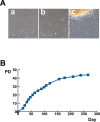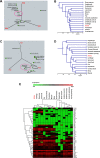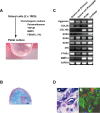Human sclera maintains common characteristics with cartilage throughout evolution
- PMID: 19002264
- PMCID: PMC2579486
- DOI: 10.1371/journal.pone.0003709
Human sclera maintains common characteristics with cartilage throughout evolution
Abstract
Background: The sclera maintains and protects the eye ball, which receives visual inputs. Although the sclera does not contribute significantly to visual perception, scleral diseases such as refractory scleritis, scleral perforation and pathological myopia are considered incurable or difficult to cure. The aim of this study is to identify characteristics of the human sclera as one of the connective tissues derived from the neural crest and mesoderm.
Methodology/principal findings: We have demonstrated microarray data of cultured human infant scleral cells. Hierarchical clustering was performed to group scleral cells and other mesenchymal cells into subcategories. Hierarchical clustering analysis showed similarity between scleral cells and auricular cartilage-derived cells. Cultured micromasses of scleral cells exposed to TGF-betas and BMP2 produced an abundant matrix. The expression of cartilage-associated genes, such as Indian hedge hog, type X collagen, and MMP13, was up-regulated within 3 weeks in vitro. These results suggest that human 'sclera'-derived cells can be considered chondrocytes when cultured ex vivo.
Conclusions/significance: Our present study shows a chondrogenic potential of human sclera. Interestingly, the sclera of certain vertebrates, such as birds and fish, is composed of hyaline cartilage. Although the human sclera is not a cartilaginous tissue, the human sclera maintains chondrogenic potential throughout evolution. In addition, our findings directly explain an enigma that the sclera and the joint cartilage are common targets of inflammatory cells in rheumatic arthritis. The present global gene expression database will contribute to the clarification of the pathogenesis of developmental diseases such as high myopia.
Conflict of interest statement
Figures




Similar articles
-
Chondrogenesis in scleral stem/progenitor cells and its association with form-deprived myopia in mice.Mol Vis. 2015 Feb 6;21:138-47. eCollection 2015. Mol Vis. 2015. PMID: 25684979 Free PMC article.
-
Visual deprivation upregulates extracellular matrix synthesis by chick scleral chondrocytes.Invest Ophthalmol Vis Sci. 1994 Apr;35(5):2436-47. Invest Ophthalmol Vis Sci. 1994. PMID: 7512943
-
Hyaline cartilage formation and enchondral ossification modeled with KUM5 and OP9 chondroblasts.J Cell Biochem. 2007 Apr 1;100(5):1240-54. doi: 10.1002/jcb.21125. J Cell Biochem. 2007. PMID: 17115412
-
Biomechanics of the sclera in myopia: extracellular and cellular factors.Optom Vis Sci. 2009 Jan;86(1):E23-30. doi: 10.1097/OPX.0b013e3181940669. Optom Vis Sci. 2009. PMID: 19104466 Review.
-
The elusive scleral cartilages: Comparative anatomy and development in teleosts and avians.Anat Rec (Hoboken). 2025 Jul;308(7):1838-1850. doi: 10.1002/ar.25345. Epub 2023 Nov 9. Anat Rec (Hoboken). 2025. PMID: 37943147 Free PMC article. Review.
Cited by
-
BMP-2 Is Involved in Scleral Remodeling in Myopia Development.PLoS One. 2015 May 12;10(5):e0125219. doi: 10.1371/journal.pone.0125219. eCollection 2015. PLoS One. 2015. PMID: 25965995 Free PMC article.
-
Two cases of cartilaginous metaplasia in the sclera of Japanese White rabbits.J Toxicol Pathol. 2023 Jan;36(1):45-48. doi: 10.1293/tox.2022-0062. Epub 2022 Nov 2. J Toxicol Pathol. 2023. PMID: 36683725 Free PMC article.
-
RNA sequence analysis identified bone morphogenetic protein-2 (BMP2) as a biomarker underlying form deprivation myopia.Biochem Biophys Rep. 2022 Apr 18;30:101261. doi: 10.1016/j.bbrep.2022.101261. eCollection 2022 Jul. Biochem Biophys Rep. 2022. PMID: 35494490 Free PMC article.
-
The human lens is capable of trilineage differentiation towards osteo-, chondro-, and adipogenesis-a model for studying cataract pathogenesis.Front Bioeng Biotechnol. 2023 May 31;11:1164795. doi: 10.3389/fbioe.2023.1164795. eCollection 2023. Front Bioeng Biotechnol. 2023. PMID: 37324433 Free PMC article.
-
Identification of multipotent stem/progenitor cells in murine sclera.Invest Ophthalmol Vis Sci. 2011 Jul 25;52(8):5481-7. doi: 10.1167/iovs.11-7676. Invest Ophthalmol Vis Sci. 2011. PMID: 21788434 Free PMC article.
References
-
- Connon CJ, Meek KM, Kinoshita S, Quantock AJ. Spatial and temporal alterations in the collagen fibrillar array during the onset of transparency in the avian cornea. Exp Eye Res. 2004;78:909–915. - PubMed
-
- Yoshida S, Shimmura S, Shimazaki J, Shinozaki N, Tsubota K. Serum-free spheroid culture of mouse corneal keratocytes. Invest Ophthalmol Vis Sci. 2005;46:1653–1658. - PubMed
-
- Zhou J, Rappaport EF, Tobias JW, Young TL. Differential gene expression in mouse sclera during ocular development. Invest Ophthalmol Vis Sci. 2006;47:1794–1802. - PubMed
-
- Young TL, Guo XD, King RA, Johnson JM, Rada JA. Identification of genes expressed in a human scleral cDNA library. Mol Vis. 2003;9:508–514. - PubMed
-
- Sakaguchi Y, Sekiya I, Yagishita K, Muneta T. Comparison of human stem cells derived from various mesenchymal tissues: superiority of synovium as a cell source. Arthritis Rheum. 2005;52:2521–2529. - PubMed
Publication types
MeSH terms
Substances
LinkOut - more resources
Full Text Sources
Medical
Molecular Biology Databases
Miscellaneous

